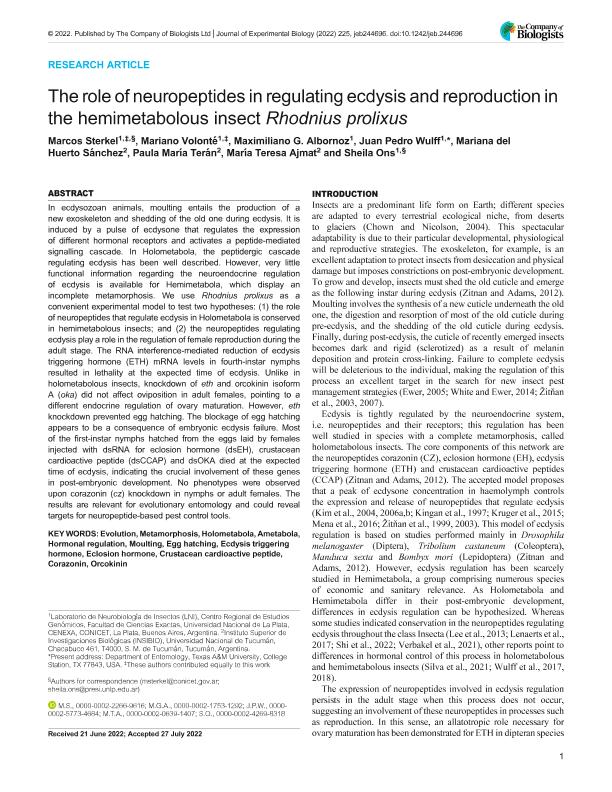Artículo
The role of neuropeptides in regulating ecdysis and reproduction in the hemimetabolous insect Rhodnius prolixus
Sterkel, Marcos ; Volonté, Mariano
; Volonté, Mariano ; Albornoz, Maximiliano Gastón; Wulff, Juan Pedro
; Albornoz, Maximiliano Gastón; Wulff, Juan Pedro ; Sanchez Matias, Mariana del Huerto
; Sanchez Matias, Mariana del Huerto ; Terán, Paula Maria
; Terán, Paula Maria ; Ajmat, María Teresa; Ons, Sheila
; Ajmat, María Teresa; Ons, Sheila
 ; Volonté, Mariano
; Volonté, Mariano ; Albornoz, Maximiliano Gastón; Wulff, Juan Pedro
; Albornoz, Maximiliano Gastón; Wulff, Juan Pedro ; Sanchez Matias, Mariana del Huerto
; Sanchez Matias, Mariana del Huerto ; Terán, Paula Maria
; Terán, Paula Maria ; Ajmat, María Teresa; Ons, Sheila
; Ajmat, María Teresa; Ons, Sheila
Fecha de publicación:
08/2022
Editorial:
Company of Biologists
Revista:
Journal of Experimental Biology
ISSN:
0022-0949
Idioma:
Inglés
Tipo de recurso:
Artículo publicado
Clasificación temática:
Resumen
In ecdysozoan animals, moulting entails the production of a new exoskeleton and shedding of the old one during ecdysis. It is induced by a pulse of ecdysone that regulates the expression of different hormonal receptors and activates a peptide-mediated signalling cascade. In Holometabola, the peptidergic cascade regulating ecdysis has been well described. However, very little functional information regarding the neuroendocrine regulation of ecdysis is available for Hemimetabola, which display an incomplete metamorphosis. We use Rhodnius prolixus as a convenient experimental model to test two hypotheses: (1) the role of neuropeptides that regulate ecdysis in Holometabola is conserved in hemimetabolous insects; and (2) the neuropeptides regulating ecdysis play a role in the regulation of female reproduction during the adult stage. The RNA interference-mediated reduction of ecdysis triggering hormone (ETH) mRNA levels in fourth-instar nymphs resulted in lethality at the expected time of ecdysis. Unlike in holometabolous insects, knockdown of eth and orcokinin isoform A (oka) did not affect oviposition in adult females, pointing to a different endocrine regulation of ovary maturation. However, eth knockdown prevented egg hatching. The blockage of egg hatching appears to be a consequence of embryonic ecdysis failure. Most of the first-instar nymphs hatched from the eggs laid by females injected with dsRNA for eclosion hormone (dsEH), crustacean cardioactive peptide (dsCCAP) and dsOKA died at the expected time of ecdysis, indicating the crucial involvement of these genes in post-embryonic development. No phenotypes were observed upon corazonin (cz) knockdown in nymphs or adult females. The results are relevant for evolutionary entomology and could reveal targets for neuropeptide-based pest control tools.
Archivos asociados
Licencia
Identificadores
Colecciones
Articulos(CENEXA)
Articulos de CENTRO DE ENDOCRINOLOGIA EXP.Y APLICADA (I)
Articulos de CENTRO DE ENDOCRINOLOGIA EXP.Y APLICADA (I)
Citación
Sterkel, Marcos; Volonté, Mariano; Albornoz, Maximiliano Gastón; Wulff, Juan Pedro; Sanchez Matias, Mariana del Huerto; et al.; The role of neuropeptides in regulating ecdysis and reproduction in the hemimetabolous insect Rhodnius prolixus; Company of Biologists; Journal of Experimental Biology; 225; 17; 8-2022
Compartir
Altmétricas



